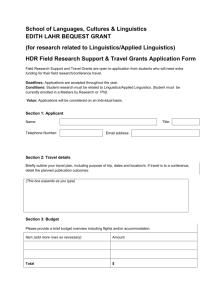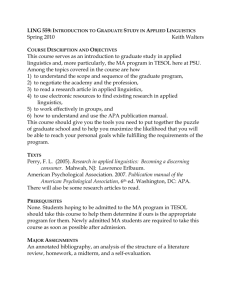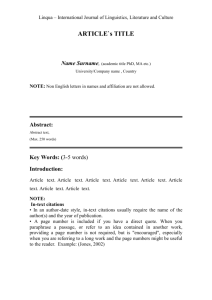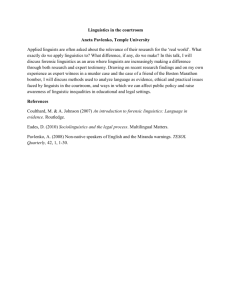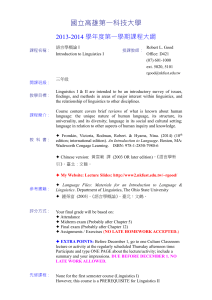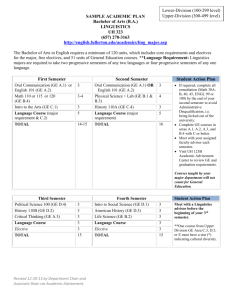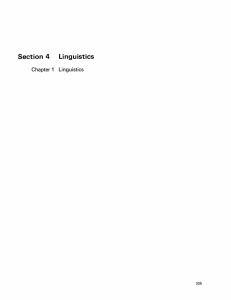Linguistics 2014 Outline
advertisement
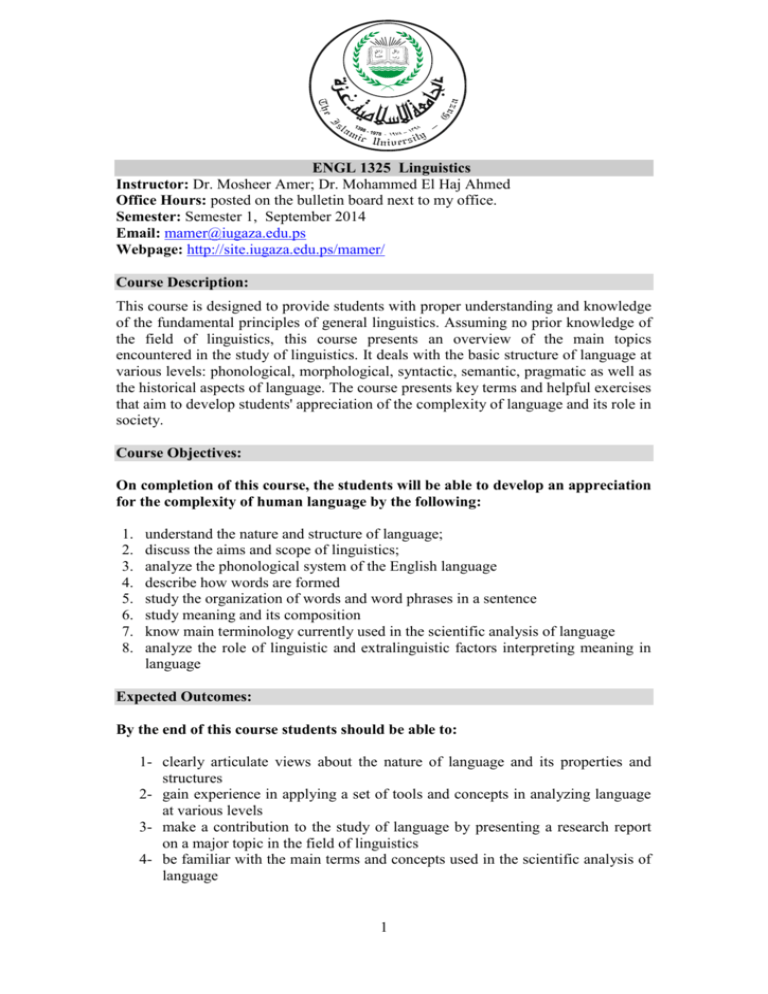
ENGL 1325 Linguistics Instructor: Dr. Mosheer Amer; Dr. Mohammed El Haj Ahmed Office Hours: posted on the bulletin board next to my office. Semester: Semester 1, September 2014 Email: mamer@iugaza.edu.ps Webpage: http://site.iugaza.edu.ps/mamer/ Course Description: This course is designed to provide students with proper understanding and knowledge of the fundamental principles of general linguistics. Assuming no prior knowledge of the field of linguistics, this course presents an overview of the main topics encountered in the study of linguistics. It deals with the basic structure of language at various levels: phonological, morphological, syntactic, semantic, pragmatic as well as the historical aspects of language. The course presents key terms and helpful exercises that aim to develop students' appreciation of the complexity of language and its role in society. Course Objectives: On completion of this course, the students will be able to develop an appreciation for the complexity of human language by the following: 1. 2. 3. 4. 5. 6. 7. 8. understand the nature and structure of language; discuss the aims and scope of linguistics; analyze the phonological system of the English language describe how words are formed study the organization of words and word phrases in a sentence study meaning and its composition know main terminology currently used in the scientific analysis of language analyze the role of linguistic and extralinguistic factors interpreting meaning in language Expected Outcomes: By the end of this course students should be able to: 1- clearly articulate views about the nature of language and its properties and structures 2- gain experience in applying a set of tools and concepts in analyzing language at various levels 3- make a contribution to the study of language by presenting a research report on a major topic in the field of linguistics 4- be familiar with the main terms and concepts used in the scientific analysis of language 1 Course Textbook and Materials The following will serve as the basis for class discussion and tasks and take-home assignments. Yule, G. (2010). The study of language (4th ed.). New York: Cambridge University Press. Other materials the course instructor finds suitable for the course. Mode of delivery This practical course is taught by way of fourteen three-hour weekly sessions. The taught sessions consist of a mix of lectures, individual and small-group tasks, class activities and student presentations. The lectures will introduce the main topics and concepts while class activities will be used for practice and reinforcement of presented concepts and skills. It is very important that you do all the readings and assignments of each session to allow for stimulating and engaged class discussions and participation. Student Assessment: Course grades will be determined roughly according to the following distribution: Final Exam --------------------------------------- 50 % Midterm Exam ---------------------------------- 20 % Assignments -------------------------------------- 10 % Research Project and Presentation ----------- 10 % Quiz ------------------------------------------------- 5 % Participation and attendance ------------------ 5% Tentative Syllabus Semester One Activity Week 1 Course introduction; What is language? An overview of language system The origins of language Animal Communication Vs. Human language 2 Properties of language Phonetics: Place and manner of articulation in English; English vowels 3 English consonants Syllables and Consonant clusters 4 Phonology: Sound patterns in English Phonemes, allophones, minimal pairs Cont'd from last session Supra-segmental features in English 5 2 Morphology: Morphemes, derivational and inflectional morphemes Word formation processes in English Roots, prefixes and suffixes 7 Syntax: The phrase, the clause and the sentence Phrase structure rules 8 Syntax Cont'd 6 Midterm Exam 9 Semantics: sematic features and semantic roles 10 Lexical relations: the lexicon, polysemy, synonymy and other meaning-related relations 11 Pragmatics: contexts, deixis and reference Speech acts 12 Neurolinguistics: Language areas in the brain Socio-linguistics: dialects, accents Bilingualism and diaglossia 13 Project Presentations 14 Project Presentations Revision Student Participation and Attendance: You are expected to attend all class sessions and to participate actively in all tasks. Try to make the most of class sessions by completing the assigned readings ahead of time and by contributing meaningfully to classroom activities. Attendance is mandatory. Students who miss 20% of the classes will not be allowed to take the final exam. References Fromkin, V., Rodman, R., & Hyams, H. (2011). An introduction to language (9th ed.). London: Wadsworth Cengage Learning. Meyer, C. (2009). Introducing English linguistics. New York: Cambridge University Press. The Ohio State University Department of Linguistics (2011). Language Files (11th ed.). Ohio: Ohio State Press. Todd, L. (1995). An introduction to linguistics (8th ed.). New York: Longman. 3


